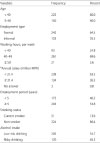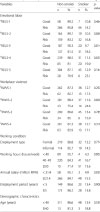1. Zahra A, Cheong HK, Park JH. Burden of disease attributable to smoking in Korea. Asia Pac J Public Health. 2017; 29(1):47–59. DOI:
10.1177/1010539516675696. PMID:
28198651.

2. Choi SH, Kim YJ, Park SY, Lee JH, Oh KW. Trends in cigarette smoking among adolescents and adults in South Korea. Epidemiology Health. 2014; 36:e2014023. DOI:
10.4178/epih/e2014023. PMID:
25358464.
4. Park MB, Kim CB, Nam EW, Hong KS. Does South Korea have hidden female smokers: discrepancies in smoking rates between self-reports and urinary cotinine level. BMC Womens Health. 2014; 14:156. DOI:
10.1186/s12905-014-0156-z. PMID:
25495192.

5. Jung-Choi KH, Khang YH, Cho HJ. Hidden female smokers in Asia: a comparison of self-reported with cotinine-verified smoking prevalence rates in representative national data from an Asian population. Tob Control. 2012; 21(6):536–542. DOI:
10.1136/tobaccocontrol-2011-050012. PMID:
21972062.

6. Cho YS, Kim HR, Myong JP, Kim HW. Association between work conditions and smoking in South Korea. Safety and Health at Work. 2013; 4(4):197–200. DOI:
10.1016/j.shaw.2013.09.001. PMID:
24422175.

7. Kim S, Kim J. The associations between smoking and occupational categories: the Korea National Health and nutrition examination survey from 2008 to 2010. Asia Pac J Public Health. 2015; 27(2):NP1752–NP1764. DOI:
10.1177/1010539512461669. PMID:
23139337.
8. Kim KW. Making a polluted space and body: labor control in a call center and the process of developing the stigma of female smoking. Korean Society Cultural Anthropology. 2015:45–87.
9. Park YJ, Lee KS, Park HN, Lee YJ, Gu HJ, Jeon MJ. The effectiveness of workplace health promotion programs using break time and environmental support on tobacco cessation among female call-center employees. Korean J Health Educ Promot. 2017;34(3). 10.14367/kjhep.2017.34.3.95.
10. labor E, women h a w. Institute for Gender and Law. 2015; 6:33–35.
12. Kim GH, Lee HS, Jung SW, Lee JG, Lee JH, Lee KJ, Kim JJ. Emotional labor, workplace violence, and depressive symptoms in female Bank employees: a questionnaire survey using the K-ELS and K-WVS. Ann Occup Environ Med. 2018 Mar 12;30(17). 10.1186/s40557-018-0229-9.
13. Yoo KM, Kim KB, Chung KJ, Kim KS. Factors that affect the hearing thresholds of call center workers. J Korean Soc Occup Environ Hyg. 2011; 21(3):168–176.
14. Chang SJ, Cha BS, Koh SB, Kang MG. Association between job characteristics and psychosocial distress of industrial workers. Korean J Prev Med. 1997; 30(1):129–144.
15. Lee KH, Chung WJ, Lee SM. Association of stress level with smoking. Korean J of Family Med. 2006; 27:42–48.
16. Kouvonen A, Kivimaki M, Virtanen M. Work stress, smoking status, and smoking intensity: an observational study of 46 190 employees. J Epidemiol Community Health. 2005; 59:63–69. DOI:
10.1136/jech.2004.019752. PMID:
15598729.

17. Son SR, Choe BM, Kim SH, Hong YS, Kim BG. A study on the relationship between job stress and nicotine dependence in Korean workers. Ann Occup Environ Med. 2016; 28:27. DOI:
10.1186/s40557-016-0113-4. PMID:
27293770.

18. Slopen N, Kontos EZ, Ryff CD, Ayanian JZ, Albert MA, Williams DR. Psychosocial stress and cigarette smoking persistence, cessation, and relapse over 9-10 years: a prospective study of middle-aged adults in the United States. Cancer Causes Control. 2013; 24(10):1849–1863. DOI:
10.1007/s10552-013-0262-5. PMID:
23860953.
19. Kim J. Association between working conditions and smoking status among Korean employees. Korean J Occup Health Nurs 2015 Aug;24(3):204–213. https://doi.org/10.5807/kjohn.2015.24.3.204.
20. Huisman M, Kunst AE, Mackenbach JP. Inequalities in the prevalence of smoking in the European Union: comparing education and income. Prev Med. 2005; 40(6):756–764. DOI:
10.1016/j.ypmed.2004.09.022. PMID:
15850876.

21. Hiscock R, Dobbie F, Bauld L. Smoking cessation and socioeconomic status: an update of existing evidence from a national evaluation of English stop smoking services. Biomed Res Int. 2015; 2015:274056. DOI:
10.1155/2015/274056. PMID:
26273602.








 Citation
Citation Print
Print



 XML Download
XML Download